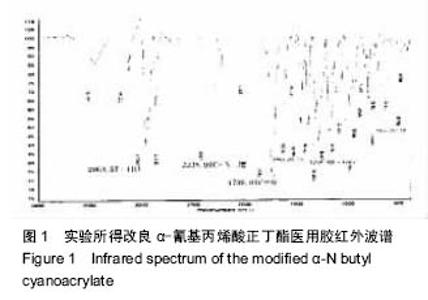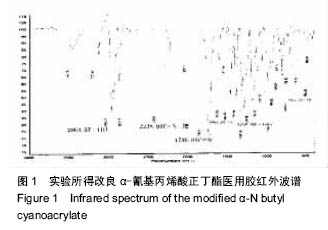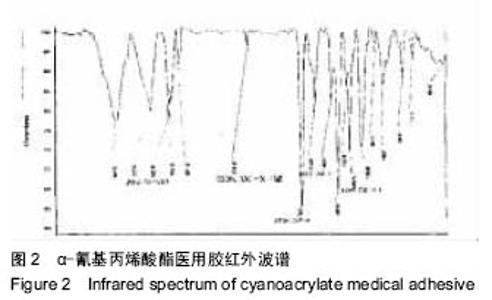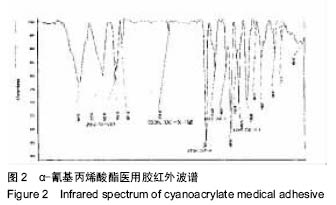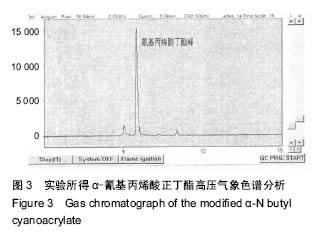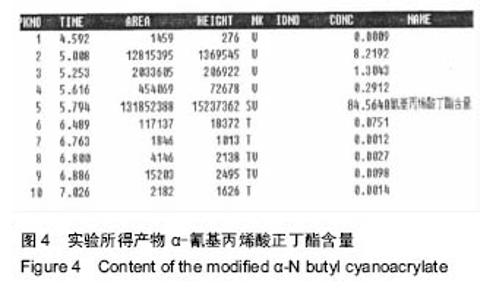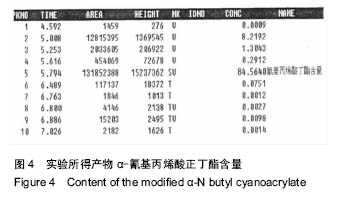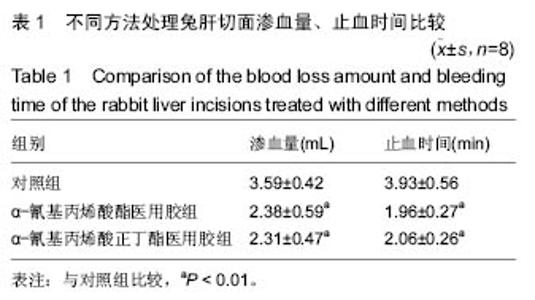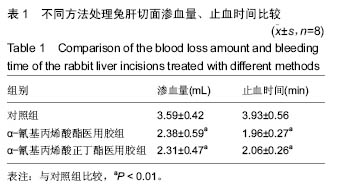Chinese Journal of Tissue Engineering Research ›› 2016, Vol. 20 ›› Issue (47): 7112-7118.doi: 10.3969/j.issn.2095-4344.2016.47.017
Previous Articles Next Articles
A chemosynthetic medical adhesive containing alpha-N butyl cyanoacrylate for liver hemostasis
- 1Department of General Surgery, Inner Mongolia People’s Hospital, Hohhot 010020, Inner Mongolia Autonomous Region, China; 2Rehabilitation Department, the Second Affiliated Hospital of Inner Mongolia Medical University, Hohhot 010050, Inner Mongolia Autonomous Region, China; 3Department of General Surgery, Affiliated Hospital of Inner Mongolia Medical University, Hohhot 010010, Inner Mongolia Autonomous Region, China
-
Received:2016-09-22Online:2016-11-18Published:2016-11-18 -
Contact:Li Jian-feng, M.D., Associate chief physician, Rehabilitation Department, the Second Affiliated Hospital of Inner Mongolia Medical University, Hohhot 010050, Inner Mongolia Autonomous Region, China -
About author:Zhang Fei, Master, Attending physician, Department of General Surgery, Inner Mongolia People’s Hospital, Hohhot 010020, Inner Mongolia Autonomous Region, China -
Supported by:the Natural Science Foundation of Inner Mongolia Autonomous Region, No. 2015MS0898
CLC Number:
Cite this article
Zhang Fei, Zhao Jun, Meng Xing-kai, Li Jian-feng. A chemosynthetic medical adhesive containing alpha-N butyl cyanoacrylate for liver hemostasis[J]. Chinese Journal of Tissue Engineering Research, 2016, 20(47): 7112-7118.
share this article
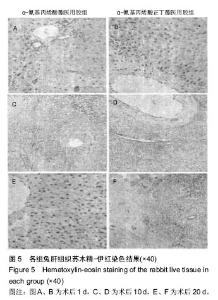
2.5 兔肝脏创面实验观察结果 2.5.1 大体观察 创面封闭胶在不同时间存留情况涂胶完毕时α-氰基丙烯酸正丁酯医用胶组与肝创面结合更紧密,不易形成胶痂脱落。术后α-氰基丙烯酸正丁酯医用胶组和α-氰基丙烯酸酯医用胶组肝切除创面均与大网膜和周围肠管黏连,分离黏连,可见白色质硬薄膜状物残留。α-氰基丙烯酸正丁酯医用胶组术后10 d肝创面可见极少量白色质硬薄膜状物覆盖,术后20 d无质硬薄膜状物存留,α-氰基丙烯酸酯医用胶组也可见相似变化。 2.5.2 病理组织学检查 术后α-氰基丙烯酸正丁酯医用胶组肝创面处可见白色凝胶团块、充血、水肿、新生肉芽组织增生及异物巨噬细胞。白色凝胶团块与肝组织结合紧密,切口周围肝窦明显充血;术后10 d肝切口处可见微量白色凝胶团块,肝组织轻度充血水肿;术后 20 d肝切口处无白色凝胶团块,肝组织未见充血水肿等异常变化,切口已纤维性愈合,切口周围肝组织无异常变化;α-氰基丙烯酸酯医用胶组也可见到与α-氰基丙烯酸正丁酯医用胶组相似的变化,但白色凝胶团块与肝组织结合性欠佳(见图5)。"
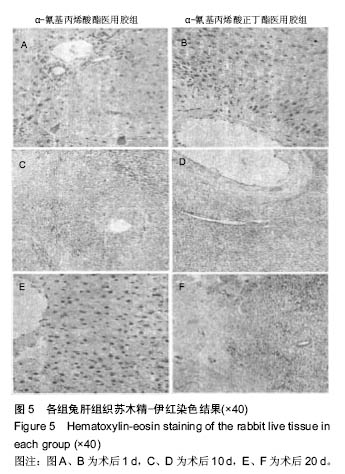
| [1]Singer AJ, Thode Jr HC, Hoilder JE. National trends in emergency department lacerations between 1992-2002. Am J Emeig Med. 2006;24(1): 183-188. [2]Brown SJ, McNab AA. Ethmoid Silent Sinus Syndrome Following Orbital Trauma.Ophthal Plast Reconstr Surg. 2016. [3]Tuscan CA. US maricets for current and emerging wound closure technologies. Med Tech Insight. 2002; 20(8):15-18. [4]Cohn HI, Teng JM. Advancement in management of epidermolysis bullosa. Curr Opin Pediatr. 2016;28(4): 507-516. [5]Stout EI, McKessor A. Glycerin-Based Hydrogel for Infection Control.Adv Wound Care (New Rochelle). 2012;1(1):48-51. [6]Hall J, Weir S, Ladlow J. Treatment of canine aural haematoma by UK veterinarians. J Small Anim Pract. 2016;57(7):360-364. [7]Tok M, Tüyde? O, Yüksel A, et al. Early-Term Outcomes for Treatment of Saphenous Vein Insufficiency with N-Butyl Cyanoacrylate: A Novel, Non-Thermal, and Non-Tumescent Percutaneous Embolization Technique. Heart Surg Forum. 2016;19(3):E118-122. [8]Litvinov RI, Weisel JW. What Is the Biological and Clinical Relevance of Fibrin?Semin Thromb Hemost. 2016;42(4):333-343. [9]Tripathi A, Gupta A, Bagchi S, et al. Comparison of the Effect of Addition of Cyanoacrylate, Epoxy Resin, and Gum Arabic on Surface Hardness of Die Stone. J Prosthodont. 2016;25(3):235-240. [10]Bagherpour Doun SK, Alavi SE, et al. Efficacy of Cisplatin-loaded poly butyl cyanoacrylate nanoparticles on the ovarian cancer: an in vitro study. Tumour Biol. 2014;35(8):7491-7497. [11]Souliotis K, Kalemikerakis I, Saridi M,et al. A cost and clinical effectiveness analysis among moist wound healing dressings versus traditional methods in home care patients with pressure ulcers. Wound Repair Regen. 2016;24(3):596-601. [12]Wang WP, Hul J, Sui H, et al. Glabridin nanosuspension for enhanced skin penetration: formulation optimization, in vitro and in vivo evaluation. Pharmazie. 2016;71(5):252-257. [13]Guex JJ. Endovenous chemical (and physical) treatments for varices: what's new? Phlebology. 2014; 29(1 suppl):45-48. [14]杨小刚,邓兆群.医用α-氰基丙烯酸乙酯的合成[J].湖北医科大学学报,1996,17(4): 305-308. [15]Inacio R, Barlow D, Kong X, et al. Investigating how the attributes of self-associated drug complexes influence the passive transport of molecules through biological membranes.Eur J Pharm Biopharm. 2016; 102:214-222. [16]Laccourrey E, O’Cauchoi S, R’Sharkaw Y, et al. Octylcyanoacrylate for sink closure at the time of hand and neck surgery:a longitudinal prospective study. Ann Chir. 2005;130(20):624-630. [17]曾国蓉,冯地旺,邓德贤.新型医用粘合α-氰基丙烯酸1,2 -异丙叉甘油酯合成[J].中国胶粘剂,1993, 2(1):20-21. [18]田霞,卢永顺.特种胶粘剂α-氰基丙烯酸酯系医用胶[J].化工新型材料,2007,35(3):113 -114. [19]Singer AJ, Hollander JE, Quinn JV. Evaluation and management of traumatic lacerations. N Engl J Med. 1997;40(2):114-148. [20]Hollander JE, Singer AJ. Application of tissue adhesive rapid attainment of proficiency. Acad Emerg Med.1998; 30(5):1012-1017. [21]Adam J, Singer MD, James V, et al. The cyanoacrylate topical skin adhesives . Am J Emerg Med. 2008; 15(8): 491-492. [22]Osmond MH, Klassen TP, Quinn JV. Economic comparision of a tissue adhesive and suturing in the repair of pediatirc facial lacertions. Pediatr. 1995; 126(6):892-895. [23]Singer AJ, Hollander JE. Association of training level and short term cosmetic appearance of repaired. Acad Emeig Med.1996;15(3):378-383. [24]Coover HW, Joyner FB, Shearer NH, et al. Chemistry and performance of cyanoacrylate adhesives. Soc Plast Eng.1959;12(2):413-417. [25]Spauwen PH, de laat WA, Hartman EH. Octy l -2 cyanoacrylate tissue glue versus monocry l6 ×0 sutures in lip closure. Cleft Palate. 2006;43(2):625-627. [26]Zhang SN, Chen T, Guo YG, et al. The stability and controlled release of I-ascorbic acid encapsulated in poly (ethyl-2-cyanoacrylate) nanocapsules prepared by interfacial polymerization of water-in-oil microemulsions. J Cosmet Sci. 2015;66(4):247-259. [27]刘芝兰,张健民,陈立贵.医用粘合剂的研究及临床应用进展[J]. 粘接,2002,23(1):27-28. [28]Hollander JE, Singer AJ. Application of tissue adhesive rapid attainment of proficiency. Acad Emerg Med. 1998; 30(5):1012-1017. [29]Gobble K, Stark A, Stagon SP. Improved Bond Strength of Cyanoacrylate Adhesives Through Nanostructured Chromium Adhesion Layers. Nanoscale Res Lett. 2016;11(1):416. [30]Devrukhkar VN, Hegde RJ, Khare SS, et al. Evaluation of isoamyl 2-cyanoacrylate tissue adhesive in management of pediatric lacerations: An alternative to suturing. Ann Maxillofac Surg. 2015;5(1):49-54. [31]Quinn JV. Clinical approaches to the use of cyanoacrylate tissue adhesives. JAMA. 2005;27(3): 15-18. [32]Monsignore LM, Elias-Junior J, Muglia VF, et al. Addition of n-butyl cyanoacrylate to classic transarterial chemoembolization may improve the radiological response in patients with hepatocellular carcinoma. Clinics (Sao Paulo). 2015;70(12):781-789. [33]Porenczuk A, Firlej P, Szczepańska G, et al. The laboratory comparison of shear bond strength and microscopic assessment of failure modes for a glass-ionomer cement and dentin bonding systems combined with silver nanoparticles.Acta Bioeng Biomech. 2016;18(2):59-70. [34]Devrukhkar VN, Hegde RJ, Khare SS, et al. Evaluation of isoamyl α-cyanoacrylate tissue adhesive in management of pediatric lacerations: An alternative to suturing. Ann Maxillofac Surg. 2015;5(1):49-54. [35]周坤,史忠.急诊医疗中医用粘合剂的研究进展[J].现代生物医学进展,2007,27(9): 1408-1411. [36]刘万章,张在新. α-氰基丙稀酸酯瞬间胶粘剂的现状和展望[J].中国胶胶粘剂,2007,16(2):41-43. [37]Kumar VA, Wickremasinghe NC, Shi S, et al. Nanofibrous Snake Venom Hemostat. ACS Biomater Sci Eng. 2015;1(12):1300-1305. [38]王波,邸明伟,郭金彦,等. α-氰基丙稀酸酯胶接性能的改进[J].粘接, 2002,21(2):16-18. [39]熊建义,刘建军,魏胜,等.医用胶粘剂主体材料α-氰基丙烯酸正辛酯的合成研究[J].湘潭大学自然科学学报, 2005, 27(2):102 -103. [40]殷晓煜,华云朋.应用医用胶减少肝断面渗血的随机对照对照研究[J].中国实用外科杂志,2003,23(11):669-670. [41]Chauvierre C, Leclerc L, Labarre D, et al. Enhancing the tolerance of poly(isobutylcyanoacrylate) nanoparticles with a modular surface design. Int J Pharm. 2007;338(1-2):327-332. |
| [1] | Zhang Tongtong, Wang Zhonghua, Wen Jie, Song Yuxin, Liu Lin. Application of three-dimensional printing model in surgical resection and reconstruction of cervical tumor [J]. Chinese Journal of Tissue Engineering Research, 2021, 25(9): 1335-1339. |
| [2] | Zeng Yanhua, Hao Yanlei. In vitro culture and purification of Schwann cells: a systematic review [J]. Chinese Journal of Tissue Engineering Research, 2021, 25(7): 1135-1141. |
| [3] | Xu Dongzi, Zhang Ting, Ouyang Zhaolian. The global competitive situation of cardiac tissue engineering based on patent analysis [J]. Chinese Journal of Tissue Engineering Research, 2021, 25(5): 807-812. |
| [4] | Wu Zijian, Hu Zhaoduan, Xie Youqiong, Wang Feng, Li Jia, Li Bocun, Cai Guowei, Peng Rui. Three-dimensional printing technology and bone tissue engineering research: literature metrology and visual analysis of research hotspots [J]. Chinese Journal of Tissue Engineering Research, 2021, 25(4): 564-569. |
| [5] | Chang Wenliao, Zhao Jie, Sun Xiaoliang, Wang Kun, Wu Guofeng, Zhou Jian, Li Shuxiang, Sun Han. Material selection, theoretical design and biomimetic function of artificial periosteum [J]. Chinese Journal of Tissue Engineering Research, 2021, 25(4): 600-606. |
| [6] | Liu Fei, Cui Yutao, Liu He. Advantages and problems of local antibiotic delivery system in the treatment of osteomyelitis [J]. Chinese Journal of Tissue Engineering Research, 2021, 25(4): 614-620. |
| [7] | Li Xiaozhuang, Duan Hao, Wang Weizhou, Tang Zhihong, Wang Yanghao, He Fei. Application of bone tissue engineering materials in the treatment of bone defect diseases in vivo [J]. Chinese Journal of Tissue Engineering Research, 2021, 25(4): 626-631. |
| [8] | Zhang Zhenkun, Li Zhe, Li Ya, Wang Yingying, Wang Yaping, Zhou Xinkui, Ma Shanshan, Guan Fangxia. Application of alginate based hydrogels/dressings in wound healing: sustained, dynamic and sequential release [J]. Chinese Journal of Tissue Engineering Research, 2021, 25(4): 638-643. |
| [9] | Chen Jiana, Qiu Yanling, Nie Minhai, Liu Xuqian. Tissue engineering scaffolds in repairing oral and maxillofacial soft tissue defects [J]. Chinese Journal of Tissue Engineering Research, 2021, 25(4): 644-650. |
| [10] | Xing Hao, Zhang Yonghong, Wang Dong. Advantages and disadvantages of repairing large-segment bone defect [J]. Chinese Journal of Tissue Engineering Research, 2021, 25(3): 426-430. |
| [11] | Liu Fang, Shan Zhengming, Tang Yulei, Wu Xiaomin, Tian Weiqun. Effects of hemostasis and promoting wound healing of ozone sustained-release hydrogel [J]. Chinese Journal of Tissue Engineering Research, 2021, 25(22): 3445-3449. |
| [12] | Chen Siqi, Xian Debin, Xu Rongsheng, Qin Zhongjie, Zhang Lei, Xia Delin. Effects of bone marrow mesenchymal stem cells and human umbilical vein endothelial cells combined with hydroxyapatite-tricalcium phosphate scaffolds on early angiogenesis in skull defect repair in rats [J]. Chinese Journal of Tissue Engineering Research, 2021, 25(22): 3458-3465. |
| [13] | Wang Hao, Chen Mingxue, Li Junkang, Luo Xujiang, Peng Liqing, Li Huo, Huang Bo, Tian Guangzhao, Liu Shuyun, Sui Xiang, Huang Jingxiang, Guo Quanyi, Lu Xiaobo. Decellularized porcine skin matrix for tissue-engineered meniscus scaffold [J]. Chinese Journal of Tissue Engineering Research, 2021, 25(22): 3473-3478. |
| [14] | Mo Jianling, He Shaoru, Feng Bowen, Jian Minqiao, Zhang Xiaohui, Liu Caisheng, Liang Yijing, Liu Yumei, Chen Liang, Zhou Haiyu, Liu Yanhui. Forming prevascularized cell sheets and the expression of angiogenesis-related factors [J]. Chinese Journal of Tissue Engineering Research, 2021, 25(22): 3479-3486. |
| [15] | Liu Chang, Li Datong, Liu Yuan, Kong Lingbo, Guo Rui, Yang Lixue, Hao Dingjun, He Baorong. Poor efficacy after vertebral augmentation surgery of acute symptomatic thoracolumbar osteoporotic compression fracture: relationship with bone cement, bone mineral density, and adjacent fractures [J]. Chinese Journal of Tissue Engineering Research, 2021, 25(22): 3510-3516. |
| Viewed | ||||||
|
Full text |
|
|||||
|
Abstract |
|
|||||
